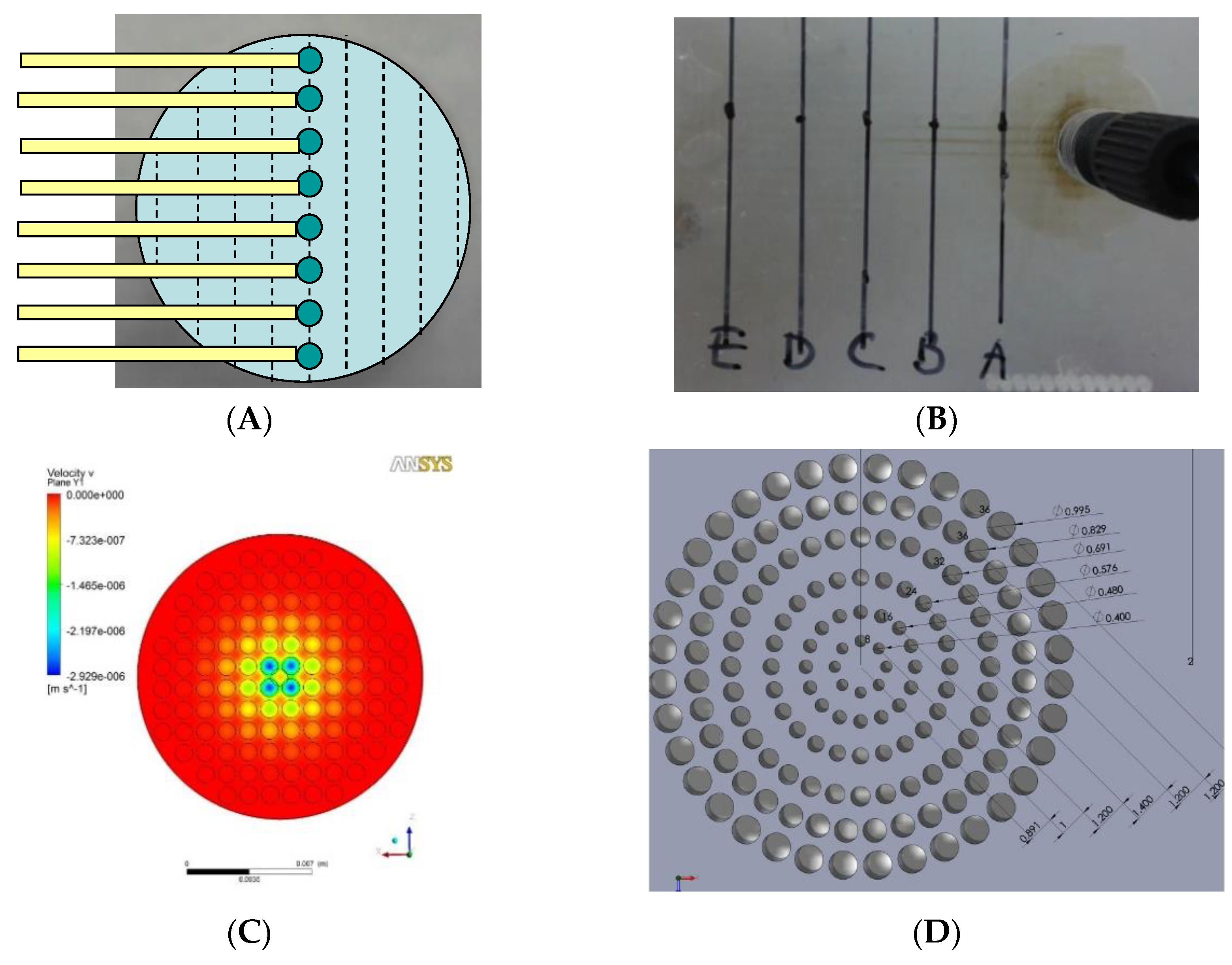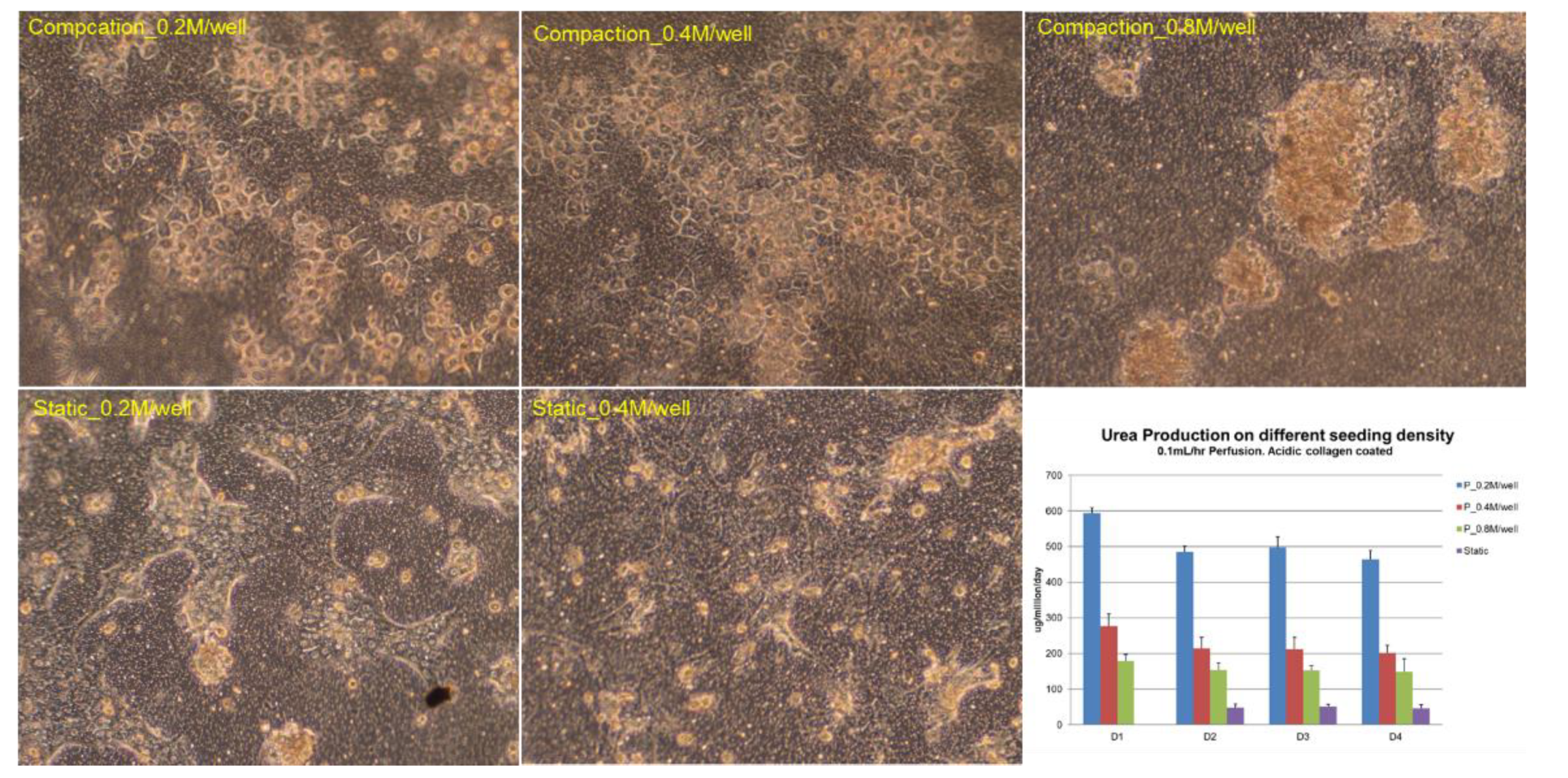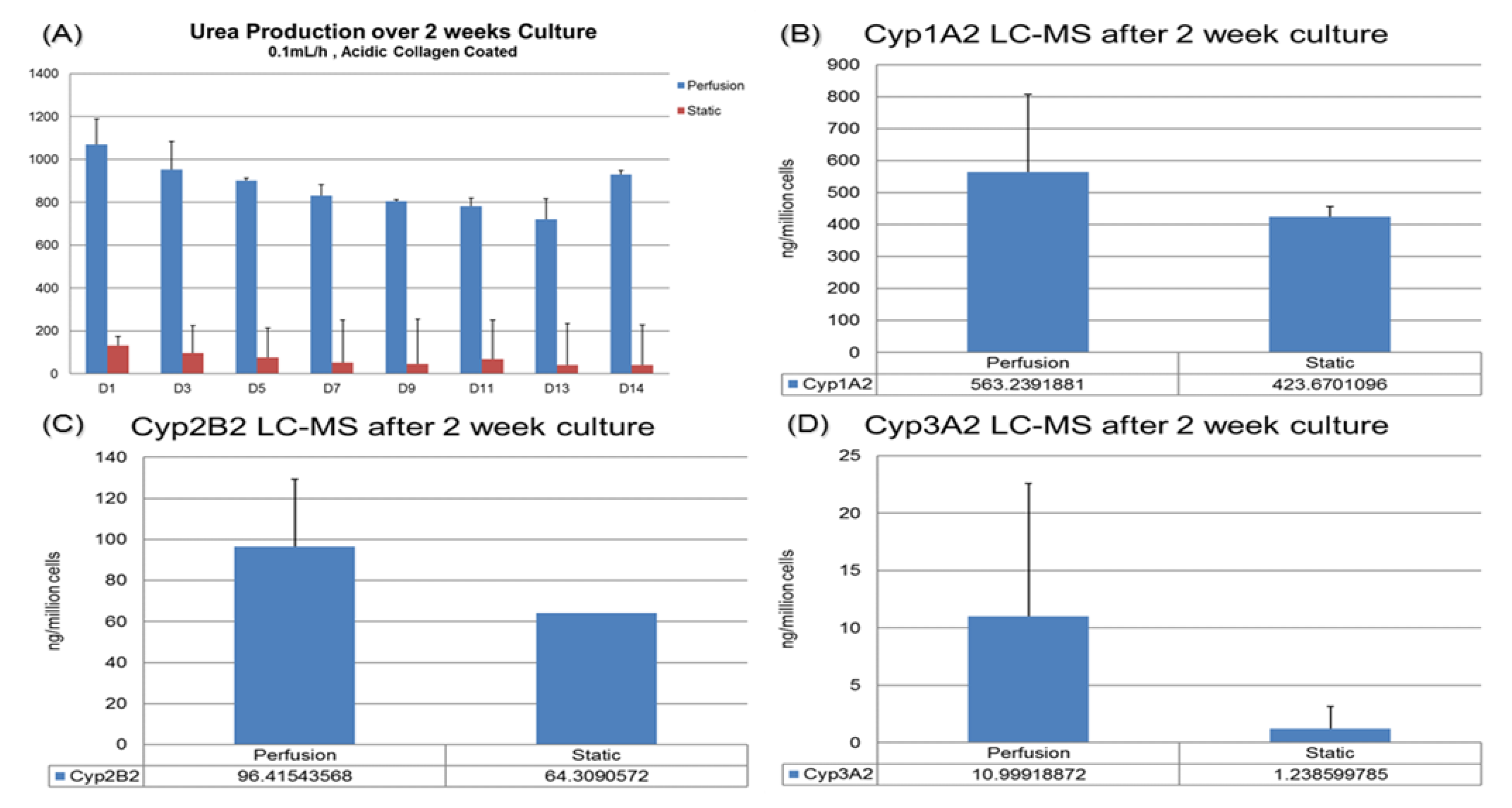Design and Fabrication of the Vertical-Flow Bioreactor for Compaction Hepatocyte Culture in Drug Testing Application
Abstract
:1. Introduction
2. Materials and Methods
2.1. Bioreactor Design and Fabrication
2.2. Cell Seeding and Culture
2.3. Hepatic Function Test
3. Results and Discussion
3.1. Design and Principles
- Minimize the shear stress: At a given flow rate, the expansion of the cross section area perpendicular to the flow direction may result in the decrease of velocity, thus lowering the shear stress at the exit of the expansion structure, which serves as the “flow enlarger” in the VfB. The “membrane filter”, sandwiched between the two layers of the cap, also serves as a shear stress filter, as the membrane was track-etched with micro-pores (Φ0.4 or 3 μm) so that the high resistance of these pores will force the perfusion flow to sieve through the membrane. This would lower the impact of perfusion flow onto the fragile cells below the filter, mimicking the in vivo condition of plasma sieving through blood vessel walls (e.g., pore size Φ0.4 μm on mice vessels) [21] (Figure 1B and Figure 3A).
- Even distribution of flow across the whole cross section area: As the diameter of the perfusion tubing is as small as Φ1 mm while the diameter of the membrane filter is expanded to Φ15 mm, a “flow distributor” is needed to dissipate the flow to the periphery of the culture chamber and force the flow velocity to distribute evenly across the area of the culture chamber below (Figure 2F). If the through hole array in the flow distributor were of the same size and arranged at the same intervals, the flow velocity of the media would be much faster at the center than at the sides (Figure 2B) when taking sampling points across the diameter (Figure 2A). It is therefore important to increase the flow resistance in the middle. The computational fluidic dynamic (CFD) simulation showed that the flow velocity was much more evenly distributed after this adjustment, other than the part for accommodating ring clips (Figure 2C versus Figure 2E).
- Low buffer volume for in-time media replenishment: As the cells in the perfusion path of VfB receives 100% perfusate due to the vertical-flow design, the flow rate is controlled at a much lower level than the horizontal or cross-flow bioreactor types due to the minimized loss of flow portion in parallel with the cell seeding plane. The volume before the cell substrate, considering as the “buffer volume” was then kept at a low level so that the media replenishment rate may still be maintained. Since the cell culture area needs to be large, the height of the cell culture chamber, which is the distance between the membrane filter and the cell seeding membrane, needs to be kept low. This is the reason why the culture chambers in VfB are shallow—to achieve a low buffer volume for in-time media replenishment.
- Enough cell number per data point: In prevalent microfluidic culture devices, the cell number per data point is commonly limited by the micro-chambers. For example, the 3D-μFCCS (3D microfluidic channel-based cell culture system) previously developed could only accommodate several thousand hepatocytes [6], making it difficult to do downstream assays such as RNA extraction and immunofluorescence staining. Since the flow distributor may expand the area at the membrane filter part, the cell seeding membrane below should also be designed at the same area so as to accommodate enough cells for each chamber.
- Controllable Compaction: In the report from Wang et al. [9], the compaction generated by the pressure applied on the ceiling of the elastic microchannel may positively modulate the cells inside. The compaction described in their paper, however, was performed by manually controlled tweezers. Here, the perfusion flow regulated by the external pump would also generate compaction force, but in a controllable way. When the flow resistance increases through integrating the micro-pore membrane at the outlet of the flow path, the pressure will build up until it is high enough to drive the perfusate through the nano pores. This pressure will then act as the compaction onto the cells cultured inside the chamber, in an even and controllable way. In our previous study, we have demonstrated that this compaction enhanced cell polarity and functions [11].
- Efficient mass delivery: The vertical-flow design allows all the media to pass through the cell culture membrane, enabling better media delivery to the cells. In order to supply enough O2 in the perfused media, a gas permeable tubing was used as the O2 generator before the perfusate reaches from syringe pump to the bioreactor. Specifically, in a drug testing application, it is important to avoid adsorption by the ECM (extra-cell matrix) overlay when adding the drug onto the cells in culture. Since the 2D cell culture setup in VfB may result in a similar morphology seen in 3D culture and in vivo, no overlay of ECM on top of the cells is needed, due to the compaction culture condition [11].
- Biocompatibility: All wet parts which comes into contact with culture media or cells were made from biocompatible materials. The main body is constructed with thermoplastic polymethyl methacrylate (PMMA), which has been reported to be compatible with various cell types including hepatocytes [22,23]. The VfB adopted commercially available Transwell® Polyester (PET) membranes as the cell seeding substrates, which are proven to be cell friendly and used widely for cell culture.
- Scalable Throughput: For drug testing purposes, a multi-well design is preferred for the purpose of high throughput. The VfB shares the same design culture chamber unit as a module, which enables flexible throughput from a single well, to double, 24 wells or higher. For instance, in order to scale up to a 24-well culture plate footprint, we could fabricate 6 groups of 4-well units to combine as an array [11]. The VfB is therefore flexible in throughput, and able to cater to various scale requirements in product design.
3.2. Device Fabrication and Thermo-Bonding Optimization
3.3. Prepare VfB for Cell Seeding
- Prepare 1:10 dilution of collagen gel stock in 0.1 N HCl at room temperature to achieve 0.3 mg/mL acidic collagen.
- Soak PET membrane in acidic collagen with a volume of 1 mL/well in 12-well plate. Make sure the whole cell seeding areas are immersed.
- Keep the 12-well plate in 37 °C incubator for 2 to 3 h.
- Wash three times with 5 min interval in 2 mL/well PBS in order to remove acidic solution thoroughly.
- Replace PBS with 1 mL/well Rat-Hep-WE and keep the membrane wet until prior to cell seeding.
3.4. Optimization of Cell Seeding Density in the VfB
3.5. Hepatic Functions Were Enhanced to Facilitate Drug Testing Applications
4. Conclusions
Author Contributions
Funding
Institutional Review Board Statement
Informed Consent Statement
Data Availability Statement
Acknowledgments
Conflicts of Interest
References
- Ebrahimkhani, M.R.; Neiman, J.A.S.; Raredon, M.S.B.; Hughes, D.J.; Griffith, L.G. Bioreactor Technologies to Support Liver Function In Vitro. Adv. Drug Deliv. Rev. 2014, 69, 132–157. [Google Scholar] [CrossRef] [Green Version]
- Bartolo, L.D.; Leindlein, A.; Hofmann, D.; Bader, A.; Grey, A.D.; Curcio, E.; Drioli, E. Bio-hybrid Organs and Tissues for Patient Therapy: A Future Vision for 2030. Chem. Eng. Process. Process Intensif. 2012, 51, 79–87. [Google Scholar] [CrossRef]
- Baudoin, R.; Corlu, A.; Griscom, L.; Legallais, C.; Leclerc, E. Trends in the Development of Microfluidic Cell Biochips for In Vitro Hepatotoxicity. Toxicol. Vitr. 2007, 21, 535–544. [Google Scholar] [CrossRef] [PubMed]
- Chan, C.Y.; Huang, P.; Guo, F.; Ding, X.; Kapur, V.; Mai, J.D.; Yuen, P.K.; Huang, T.J. Accelerating Drug Discovery via Organs-on-chips. Lab Chip 2013, 13, 4697–4710. [Google Scholar] [CrossRef] [PubMed] [Green Version]
- Goral, V.N.; Hsieh, Y.-C.; Petzold, O.N.; Clark, J.S.; Yuen, P.K.; Faris, R.A. Perfusion-Based Microfluidic Device for Three-Dimensional Dynamic Primary Human Hepatocyte Cell Culture in the Absence of Biological or Synthetic Matrices or Coagulants. Lab Chip 2010, 10, 3380–3386. [Google Scholar] [CrossRef]
- Toh, Y.-C.; Zhang, C.; Zhang, J.; Khong, Y.M.; Chang, S.; Samper, V.D.; Noort, D.; Hutmacher, D.W.; Yu, H. A Novel 3D Mammalian Cell Perfusion-Culture System in Microfluidic Channels. Lab Chip 2007, 7, 302–309. [Google Scholar] [CrossRef]
- Tilles, A.W.; Baskaran, H.; Roy, P.; Yarmush, M.L.; Toner, M. Effects of Oxygenation and Flow on the Viability and Function of Rat Hepatocytes Cocultured in a Microchannel Flat-Plate Bioreactor. Biotechnol. Bioeng. 2001, 73, 379–389. [Google Scholar] [CrossRef]
- Toh, Y.-C.; Lim, T.C.; Tai, D.; Xiao, G.; Noort, D.V.; Yu, H. A Microfluidic 3D Hepatocyte Chip for Drug Toxicity Testing. Lab Chip 2009, 9, 2026–2035. [Google Scholar] [CrossRef]
- Wang, Y.; Toh, Y.-C.; Li, Q.; Nugraha, B.; Zheng, B.; Lu, T.B.; Gao, Y.; Ng, M.M.L.; Yu, H. Mechanical Compaction Directly Modulates the Dynamics of Bile Canaliculi Formation. Integr. Biol. 2013, 5, 390–401. [Google Scholar] [CrossRef]
- Zhu, L.; Tong, W.H.; Toh, Y.-C.; Deepak, C.; Wang, Z.; Liescu, C.; Yu, H. Enhanced Micro-feature on Glass Silicon Microfluidic Channel of 3D Hepatocyte Culture Device. In Proceedings of the 9th World Biomaterials Congress (ID: 2603 P-MON-B-201), Chengdu, China, 1–5 June 2012. [Google Scholar]
- Zhu, L.; Xia, H.; Wang, Z.; Fong, E.L.S.; Fan, J.; Seah, D.Y.P.; Zhang, W.; Li, Q.; Yu, H. A Vertical-Flow Bioreactor Array Compacts Hepatocytes for Enhanced Polarity and Functions. Lab Chip 2016, 16, 3898–3908. [Google Scholar] [CrossRef] [PubMed]
- Nguyen, T.; Chidambara, V.A.; Andreasen, S.Z.; Golabi, M.; Huynh, V.N.; Linh, Q.T.; Bang, D.D.; Wolff, A. Point-of-care devices for pathogen detections: The three most important factors to realise towards commercialization. TrAC Trends Anal. Chem. 2020, 131, 116004. [Google Scholar] [CrossRef]
- Liga, A.; Morton, J.A.S.; Kersaudy-Kerhoas, M. Safe and Cost-Effective Rapid-Prototyping of Multilayer PMMA Microfluidic Devices. Microfluid. Nanofluidics 2016, 20, 164. [Google Scholar] [CrossRef] [Green Version]
- Morelli, S.; Salerno, S.; Piscioneri, A.; Rende, M.; Campana, C.; Bartolo, L.D. Membrane Approaches for Liver and Neuronal Tissue Engineering. Enrico Drioli Lidietta Giorno Compr. Membr. Sci. Eng. 2010, 3, 229–252. [Google Scholar]
- Ahmed, S.; Chauhan, V.M.; Ghaemmaghami, A.M.; Aylott, J.W. New Generation of Bioreactors that Advance Extracellular Matrix Modelling and Tissue Engineering. Biotechnol. Lett. 2019, 41, 1–25. [Google Scholar] [CrossRef] [Green Version]
- Chen, C.-Y.; Chiang, T.-S.; Chiou, L.-L.; Lee, H.-S.; Lin, F.-H. 3D Cell Clusters Combined with a Bioreactor System to Enhance the Drug Metabolism Activities of C3A Hepatoma Cell Lines. J. Mater. Chem. B 2016, 4, 7000–7008. [Google Scholar] [CrossRef] [PubMed]
- Rogers, M.; Sobolik, T.; Schaffer, D.K.; Samson, P.C.; Johnson, A.C.; Owens, P.; Codreanu, S.G.; Sherrod, S.D.; McLean, J.A.; Wikswo, J.P.; et al. 2018 Engineered Microfluidic Bioreactor for Examining the Three-Dimensional Breast Tumor Microenvironment. Biomicrofluidics 2018, 12, 034102. [Google Scholar] [CrossRef]
- Goral, V.N.; Tran, E.; Yuen, P.K. A Pump-Free Membrane-Controlled Perfusion Microfluidic Platform. Biomicrofluidics 2015, 9, 054103. [Google Scholar] [CrossRef] [PubMed] [Green Version]
- Ji, H.M.; Samper, V.; Chen, Y.; Heng, C.K.; Lim, T.M.; Yobas, L. Silicon-based Microfilters for Whole Blood Cell Separation. Biomed. Microdevices 2008, 10, 251–257. [Google Scholar] [CrossRef]
- Kleis, S.J.; Geffert, S.K.; Gonda, S.R. Method and Apparatus for A Miniature Bioreactor System for Long-Term Cell Culture. U.S. Patent 9,023,642 B2, 5 May 2015. [Google Scholar]
- Hobbs, S.K.; Monsky, W.L.; Yuan, F.; Roberts, W.G.; Griffith, L.; Torchilin, V.P.; Jain, R.K. Regulation of Transport Pathways in Tumor Vessels: Role of Tumor Type and Microenvironment. Proc. Natl. Acad. Sci. USA 1998, 95, 4607–4612. [Google Scholar] [CrossRef] [Green Version]
- Hollick, E.J.; Spalton, D.J.; Ursell, P.G.; Pande, M.V. Biocompatibility of Poly(methyl Methacrylate), Silicone, and AcrySof Intraocular Lenses: Randomized Comparison of the Cellular Reaction on the Anterior Lens Surface. J. Cataract Refract. Surg. 1998, 24, 361–366. [Google Scholar] [CrossRef]
- Folch, A.; Toner, M. Cellular Micropatterns on Biocompatible Materials. Biotechnol. Prog. 1998, 14, 388–392. [Google Scholar] [CrossRef] [PubMed]
- Sun, Y.; Kwok, Y.C.; Nguyen, N.-T. Low-Pressure, High-Temperature Thermal Bonding of Polymeric Microfluidic Devices and their Applications for Electrophoretic Separation. J. Micromech. Microeng. 2006, 16, 1681–1688. [Google Scholar] [CrossRef]
- Ashby, M.F. Materials Selection in Mechanical Design, 3rd ed.; Elsevier: Amsterdam, The Netherlands, 2005. [Google Scholar]
- International Congress of Physiological Sciences, Oxygen Transport to Tissue. In Proceedings of the Satellite Symposium of the 28th International Congress of Physiological Sciences; Pergamon Press: Budapest, Hungary, 2013.
- Zhang, S.; Zhang, B.; Chen, X.; Chen, L.; Wang, Z.; Wang, Y. Three-dimensional Culture in a Microgravity Bioreactor Improves the Engraftment Efficiency of Hepatic tissue Constructs in Mice. J. Mater. Sci. Mater. Med. 2014, 25, 2699–2709. [Google Scholar] [CrossRef]
- Chaicharoenaudomrung, N.; Kunhorm, P.; Noisa, P. Three-dimensional cell culture systems as an in vitro platform for cancer and stem cell modeling. World J. Stem Cells 2019, 11, 1065–1083. [Google Scholar] [CrossRef] [PubMed]
- Eaker, S.; Abraham, E.; Allickson, J.; Brieva, T.A.; Dolores, B.; Heathman, T.R.; Mistry, B.; Zhang, N. Bioreactors for cell therapies: Current status and future advances. Cytotherapy 2017, 19, 9–18. [Google Scholar] [CrossRef]
- Farre, C.; Fertig, N. New Strategies in Ion Channel Screening for Drug Discovery: Are There Ways to Improve Its Productivity? Expert Opin. Drug Discov. 2014, 9, 1103–1107. [Google Scholar] [CrossRef] [PubMed]







| Ideal Features of Cell Culture Device for Drug Testing | Corresponding Considerations in VfB Design |
|---|---|
| Biocompatible, nontoxic material [14] | PMMA as main body, PET as cell culture substrate, with collagen coating |
| Optically transparent [15] | Transparent cell culture membrane for staining and imaging |
| Large surface area for enough cells to attach [14] | Cell culture chamber same as 24-well plate (Φ15 mm) |
| Efficient mass delivery [14] | Vertical-flow to ensure all media flow onto cells No ECM on top of cells to avoid additional adsorption of drug or media |
| Easy to assemble, insert and retrieve culture parts [15] | Open-cap design, allowing easy retrieval of cells and culture substrates |
| Flexible configuration: allow co-culture [15] | Allows for co-culture in mixture or different side of cell culture membrane |
| Scalable or High throughput [15] | Modular structure of culture wells and perfusion channels for easy scale-up |
| Ideal Features of Perfusion bioreactor for drug testing | |
| Closed culture environment [16] | Closed culture well during perfusion by embracing VfB inside the jig |
| Leak proof [15] | Seal rigid surfaces with silicone rings and fixed in jig via screws |
| Allows use of different flow types/rates [15] | Flow type/rates fully adjustable by syringe pump |
| No air bubble formation [15] | Simple structure without micro-channel features |
| Even distribution of flow across the large culture area * | Flow enlarger + Flow distributor to dissipate flow of media |
| Low buffer volume for in-time media replenishment * | Shallow culture chambers with vertical flow to efficiently replenish media |
| Minimize the shear stress * | Micro-pore membrane filter to filter shear stress Vertical flow enlarged from small to big cross section area (Φ1 to 15 mm) |
| Biometic Features | |
| Maintain 3D cell shape as in vivo [14] | Cells maintain 3D cuboidal shape with minimum stress fibers [11] |
| Controllable Compaction * | Cell compaction similar to intra-abdominal pressure (IAP) [11] |
Publisher’s Note: MDPI stays neutral with regard to jurisdictional claims in published maps and institutional affiliations. |
© 2021 by the authors. Licensee MDPI, Basel, Switzerland. This article is an open access article distributed under the terms and conditions of the Creative Commons Attribution (CC BY) license (https://creativecommons.org/licenses/by/4.0/).
Share and Cite
Zhu, L.; Wang, Z.; Xia, H.; Yu, H. Design and Fabrication of the Vertical-Flow Bioreactor for Compaction Hepatocyte Culture in Drug Testing Application. Biosensors 2021, 11, 160. https://doi.org/10.3390/bios11050160
Zhu L, Wang Z, Xia H, Yu H. Design and Fabrication of the Vertical-Flow Bioreactor for Compaction Hepatocyte Culture in Drug Testing Application. Biosensors. 2021; 11(5):160. https://doi.org/10.3390/bios11050160
Chicago/Turabian StyleZhu, Liang, Zhenfeng Wang, Huanming Xia, and Hanry Yu. 2021. "Design and Fabrication of the Vertical-Flow Bioreactor for Compaction Hepatocyte Culture in Drug Testing Application" Biosensors 11, no. 5: 160. https://doi.org/10.3390/bios11050160
APA StyleZhu, L., Wang, Z., Xia, H., & Yu, H. (2021). Design and Fabrication of the Vertical-Flow Bioreactor for Compaction Hepatocyte Culture in Drug Testing Application. Biosensors, 11(5), 160. https://doi.org/10.3390/bios11050160




